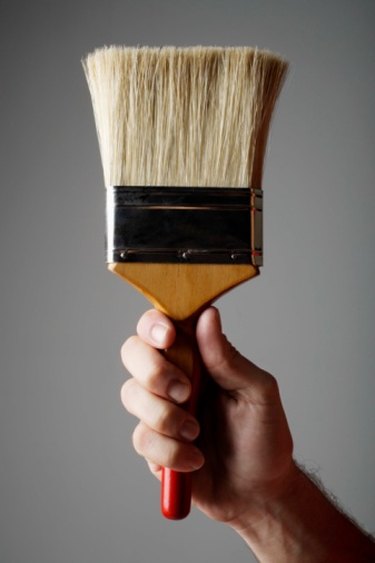Things You'll Need
Dropcloth
Hot, soapy water
Cloths
1 gallon polyurethane
Paint tray
Roller
Foam paint brush, large
Foam paint brush, small
Electric hand-held sander
Fine grit sandpaper

Polyurethane often gets applied to items you can remove and treat on a garage table or workshop. However, a polyurethane coat is sometimes necessary for walls and doors you must treat on-site. The process for working on a vertical surface instead of horizontal does not change. The main difference is to work more carefully to avoid creating drips and runs that will mar an otherwise effective treatment.
Step 1
Lay down a dropcloth beneath the vertical item to protect the flooring. Wash the item's surface well with hot soapy water from a bucket and a cloth to remove any surface dirt, oil or dust. If you do not, the polyurethane will seal in the dirt, thus affecting the way the polyurethane looks or adheres. Allow the surface time to dry completely before applying the polyurethane.
Video of the Day
Step 2
Open a 1 gallon can of polyurethane, and slowly pour some into a tray. Do not shake or stir at all to prevent the formation of air bubbles which can flaw the polyurethane finish. Pouring slowly also prevents air bubbles, which would get transferred onto the surface.
Step 3
Apply the polyurethane with a roller or large foam paint brush. Start at the top of the vertical surface, never the bottom, so the polyurethane is less likely to have thick spots and run. Roll or brush in a downward motion, spreading the polyurethane evenly downward over the surface until you have finished. Allow this coat one to two hours to dry.
Step 4
Sand the entire polyurethane surface you just applied. Do it lightly with an electric hand-held sander and fine grit sandpaper. This will remove excess, runs, drips, and air bubbles, helping the second coat adhere. Wipe the surface with a dry cloth to remove all the dust from the sanding.
Step 5
Apply as many coats of polyurethane as needed, until it as thick as you desire. Do not sand between coats unless you see obvious drips or bubbles.
Tip
Take your time to avoid mistakes.
Warning
Ventilate the area well while using polyurethane.
Video of the Day